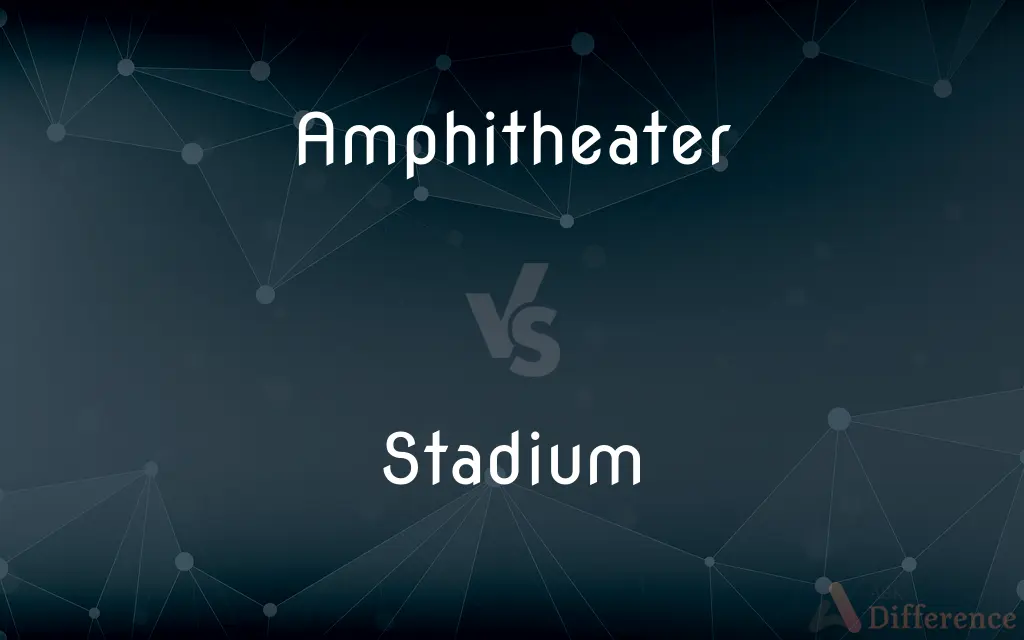Amphitheater vs. Stadium — What's the Difference?
By Maham Liaqat & Urooj Arif — Updated on February 29, 2024
An amphitheater is an open-air venue with a central stage surrounded by rising seats, traditionally used for performances and gladiatorial games, while a stadium is a large sports arena with tiers of seats for spectators, designed primarily.

Difference Between Amphitheater and Stadium
Table of Contents
ADVERTISEMENT
Key Differences
Amphitheaters, originating from ancient Rome, are circular or oval structures designed for theatrical performances and public spectacles, characterized by their open, central stage area. In contrast, stadiums are modern sports venues, often enclosed, with a field or court at the center for sporting events, concerts, and other large gatherings.
The design of an amphitheater, with its sloped seating surrounding a central performance area, ensures that all spectators have a clear view of the events taking place. This contrasts with stadiums, which may have a variety of viewing angles and distances due to their typically larger size and shape, catering to a wide range of events beyond just sports.
Amphitheaters were built from stone with a focus on acoustics, allowing voices and sounds to carry to the furthest seats without amplification. Modern stadiums, however, rely on advanced engineering and technology to accommodate large crowds and ensure everyone can see and hear the event, regardless of their seat.
The purpose of amphitheaters was primarily entertainment, such as plays, concerts, and gladiatorial games, reflecting the cultural practices of the time. Stadiums, while also hosting entertainment events, are primarily associated with sports and large-scale gatherings, reflecting contemporary interests and activities.
Despite their differences, both amphitheaters and stadiums serve as gathering places for people to experience collective enjoyment, whether it be through watching a play, a concert, or a sports game. They stand as architectural symbols of their respective eras' social and cultural values.
ADVERTISEMENT
Comparison Chart
Design
Circular or oval, with a central stage and surrounding seats.
Larger, with a central field or court and surrounding seating.
Primary Use
Theatrical performances, concerts, public spectacles.
Sporting events, concerts, large gatherings.
Historical Origin
Ancient Rome, for gladiatorial games, theater.
Ancient sports arenas, modernly adapted for a variety of events.
Structure
Open-air, stone construction with emphasis on natural acoustics.
Often enclosed, utilizing modern materials and technology.
Audience Experience
Intimate viewing experience, designed for acoustical excellence.
Can vary widely, designed for visibility and comfort across various events.
Compare with Definitions
Amphitheater
Designed for performances and public spectacles.
The amphitheater's design allowed everyone to hear the actors clearly.
Stadium
A large sports arena with seating for spectators.
The stadium was packed with fans for the football game.
Amphitheater
Circular or oval in shape.
The amphitheater's oval shape contributed to its excellent acoustics.
Stadium
Can be used for a variety of events.
The stadium hosted a concert that attracted thousands.
Amphitheater
Focuses on natural acoustics.
The amphitheater utilized its structure to enhance sound naturally.
Stadium
Designed for visibility and comfort.
Every seat in the stadium offers a clear view of the field.
Amphitheater
An open-air venue with seats surrounding a central stage.
The ancient amphitheater in Rome hosted thousands of spectators.
Stadium
Primarily associated with sports.
The stadium is home to the city's major league baseball team.
Amphitheater
Historically made from stone.
The stone construction of the amphitheater has stood for centuries.
Stadium
Often enclosed and equipped with modern technology.
The modern stadium features a retractable roof.
Amphitheater
An oval or circular structure having tiers of seats rising gradually outward from a central open space or arena.
Stadium
A stadium (plural stadiums or stadia) is a place or venue for (mostly) outdoor sports, concerts, or other events and consists of a field or stage either partly or completely surrounded by a tiered structure designed to allow spectators to stand or sit and view the event.Pausanias noted that for about half a century the only event at the ancient Greek Olympic festival was the race that comprised one length of the stadion at Olympia, where the word "stadium" originated.Most of the stadiums with a capacity of at least 10,000 are used for association football. Other popular stadium sports include gridiron football, baseball, cricket, the various codes of rugby, field lacrosse, bandy, and bullfighting.
Amphitheater
An oval or circular building with rising tiers of seats about an open space called the arena.
Stadium
A large, usually open structure for sports events with tiered seating for spectators.
Amphitheater
A sloping gallery with seats for spectators (as in an operating room or theater)
Stadium
A course on which foot races were held in ancient Greece, usually semicircular and having tiers of seats for spectators.
Amphitheater
An oval large stadium with tiers of seats; an arena in which contests and spectacles are held
Common Curiosities
Why do amphitheaters emphasize acoustics?
Amphitheaters emphasize natural acoustics to carry sound throughout the venue without electronic amplification, crucial for ancient performances.
Can amphitheaters host sports events?
While primarily designed for performances, some amphitheaters may host sports events, though they are less common.
How do the sizes of amphitheaters and stadiums compare?
Stadiums are generally larger, built to accommodate tens of thousands of spectators, while amphitheaters may be smaller.
What distinguishes a stadium?
A stadium is a large sports arena with tiers of seats for spectators, used for athletic competitions and other large-scale events.
Are all stadiums enclosed?
Not all stadiums are enclosed; some have open designs, but many modern stadiums feature enclosures or retractable roofs.
What is an amphitheater?
An amphitheater is an open-air venue with a central stage and surrounding seating, designed for performances and public spectacles.
What is the historical significance of amphitheaters?
Amphitheaters hold historical significance as venues for entertainment and public gatherings in ancient Rome and Greece.
Can a venue be both an amphitheater and a stadium?
Some modern venues blend elements of both, but traditional definitions distinguish them by purpose and design.
What modern technologies are used in stadiums?
Modern stadiums use technologies like giant video screens, sound amplification systems, and retractable roofs for comfort and visibility.
How do seating arrangements differ between the two?
Amphitheater seats are typically arranged in a circular or oval pattern around the stage, while stadium seats surround a central field or court.
Are new amphitheaters being built today?
Yes, new amphitheaters are built for cultural and entertainment purposes, often inspired by ancient designs but with modern amenities.
Can stadiums be used for events other than sports?
Yes, stadiums frequently host concerts, ceremonies, and other gatherings in addition to sports.
What is the capacity difference between amphitheaters and stadiums?
Capacity can vary widely, but stadiums often accommodate more spectators due to their larger size.
How do the locations of amphitheaters and stadiums differ?
Amphitheaters are often found in cultural or historical sites, while stadiums are typically located in urban or commercial areas.
Why might someone choose an amphitheater over a stadium for an event?
The choice might depend on the event type, desired atmosphere, and acoustical needs, with amphitheaters offering a more intimate setting.
Share Your Discovery

Previous Comparison
Dictatorship vs. Theocracy
Next Comparison
Hindi vs. SanskritAuthor Spotlight
Written by
Maham LiaqatCo-written by
Urooj ArifUrooj is a skilled content writer at Ask Difference, known for her exceptional ability to simplify complex topics into engaging and informative content. With a passion for research and a flair for clear, concise writing, she consistently delivers articles that resonate with our diverse audience.
















































